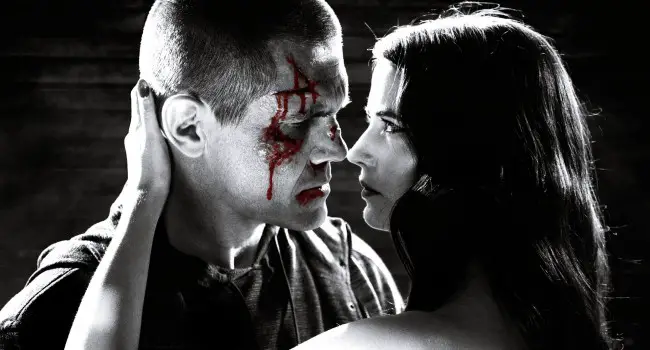Ten years passed and Rodriguez isn’t showing any major change of route, filming a movie which ends up being very similar to its ancestor: a massive, stunning visual experience partially clouded by the continuous overflow of dialogues, monologues and jokes forced on screen by a literal adaptation who blatantly chases any single quote featured by the comic. As a viewer, I often felt the frustration of watching amazing scenes (Dwight and Marv breaking in Lord mansion and the epic clash between the latter and Manute, just to mention one) and having them ruined by an excessive usage of useless, pace-killing spoken sentences. But the graphic novel had them all, someone might say: that might be true for the most part, but the fine, hard-boiled loosening feeling crafted by the few words written on paper can’t be translated on screen by simply reading them out, neither assembling them into badass-like statements. To quote Raymond Chandler, “the technical basis of the Black Mask type of story […] was that the scene outranked the plot, in the sense that a good plot was one which made good scenes”. A lesson well learned by Miller paper works as well as by talented directors such as Quentin Tarantino: too bad Rodriguez isn’t quite there yet.
The gap between the movie and its comic-book counterparts is widened out by the presence of two original short-stories (The Long Bad Night and The Fat Loss) which, altough for different reasons, happen to blend quite poorly with the series and also don’t fit so nicely into the Sin City story arc. I personally liked the first one (featuring a great Joseph Gordon-Levitt) but I definitely couldn’t stand the latter, which is easily the worst part of the whole movie.
None of the many differences between the graphic-novel and its screen adaptation have anything to do with the overall movie quality, which is perfectly fine: the sequel is fun and enjoyable to its full extent (almost) as much as the first one. If anything, the exploitation moods and tones imposed by Rodriguez are able to “compensate” the lackness of high-impact, dramatic stories such as The Hard Goodbye and That Yellow Bastard in favor of the exceeding performances of Josh Brolin, Eva Green and a no less than top notch cast. The final verdict is treatened, today like 10 years ago, by some inconsistencies in the filmmaking process and their major impact on the overall movie flow, less noticeable in the first part (featuring an excellent start with the short-story Just Another Saturday Night and the first scenes of ADTKF) but quickly escalating towards the end.
In a nutshell: go see it if you liked the first chapter: you probably won’t love it as much, but it will still be worthwile.

